History of citrus fruit, medicinal and nutritional properties. Pot cultivation of citrus fruit.
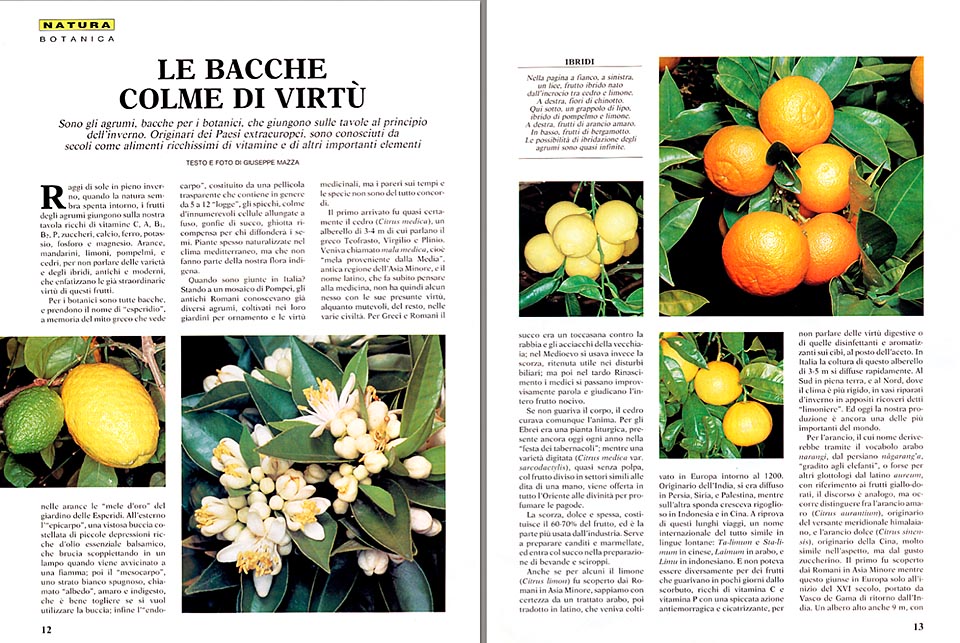
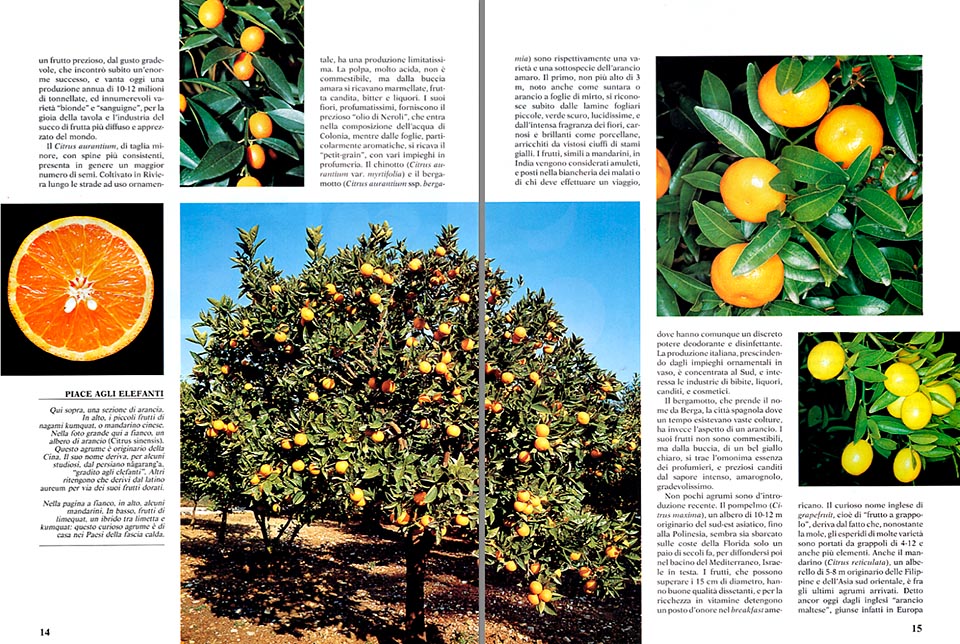
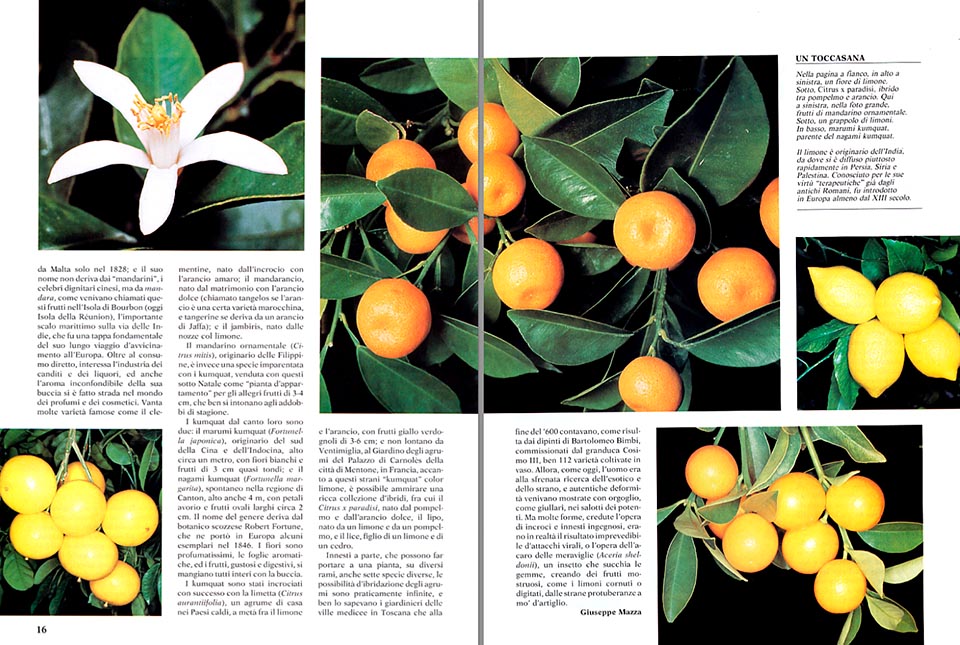
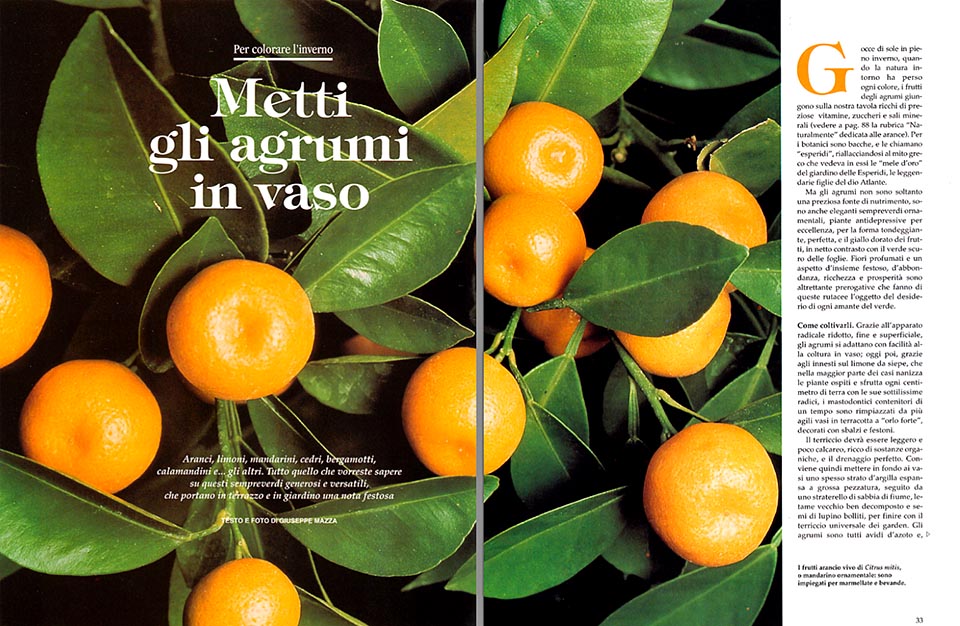
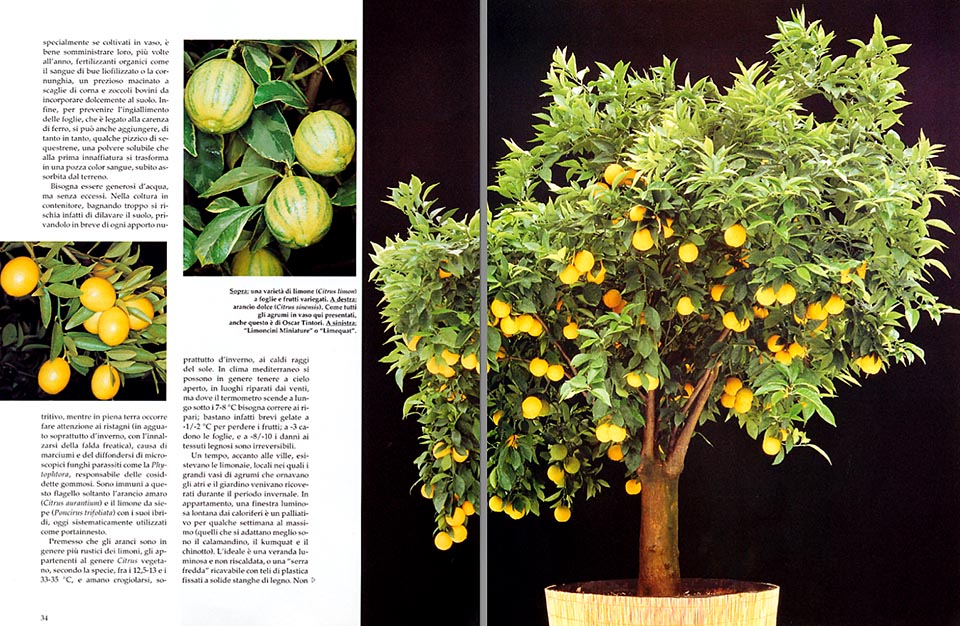
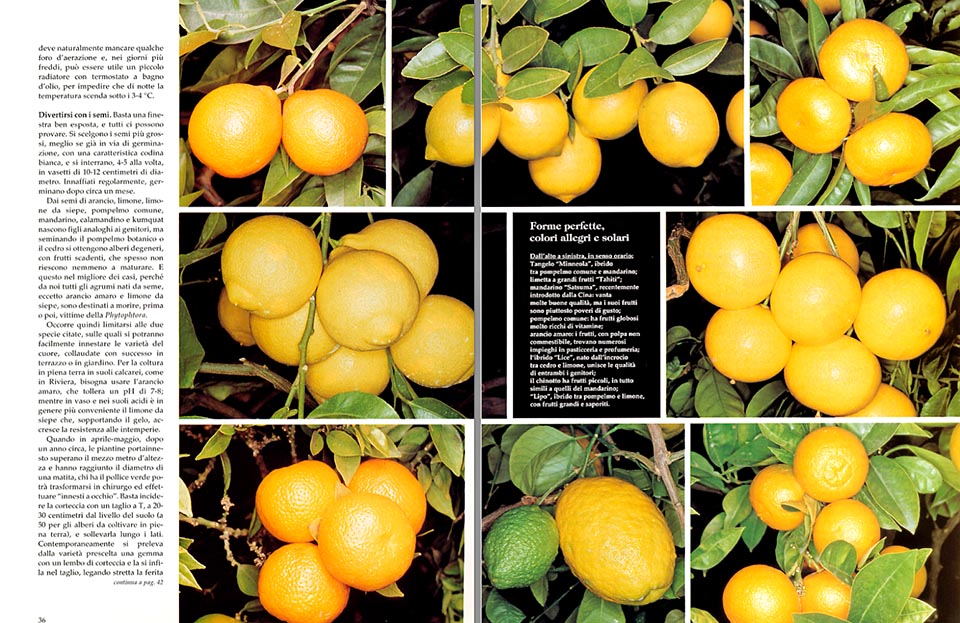
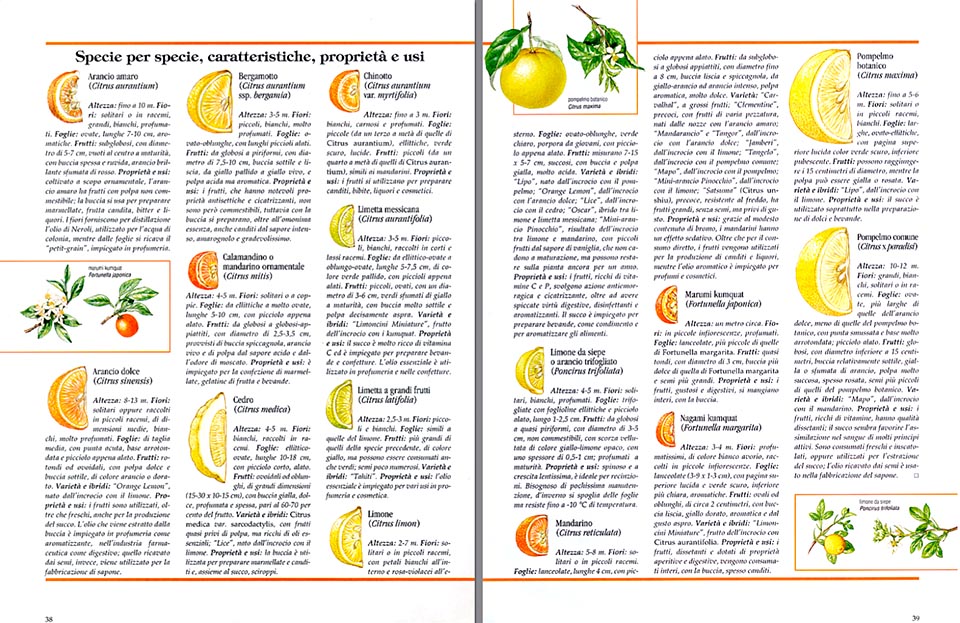
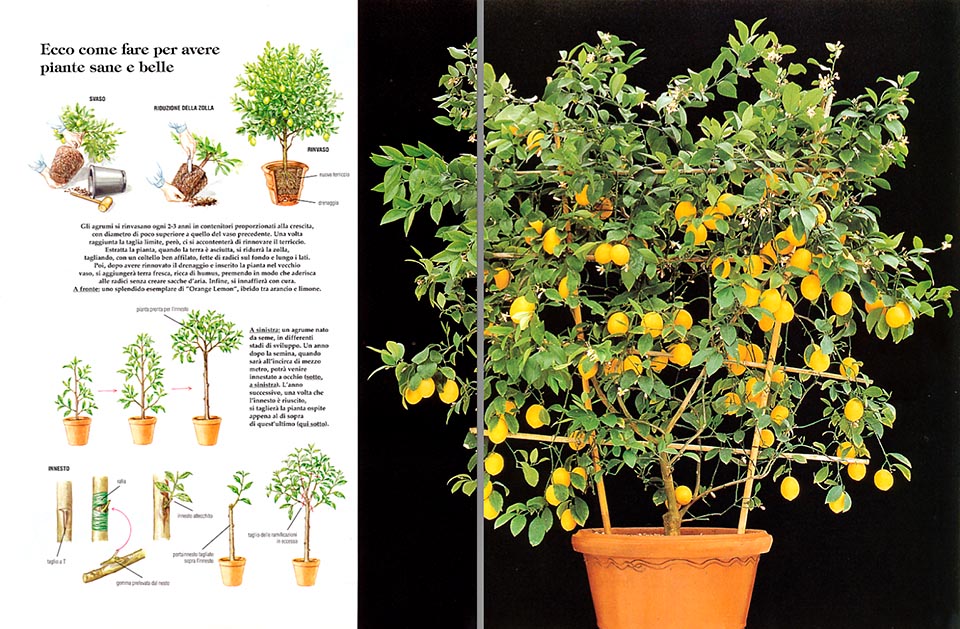
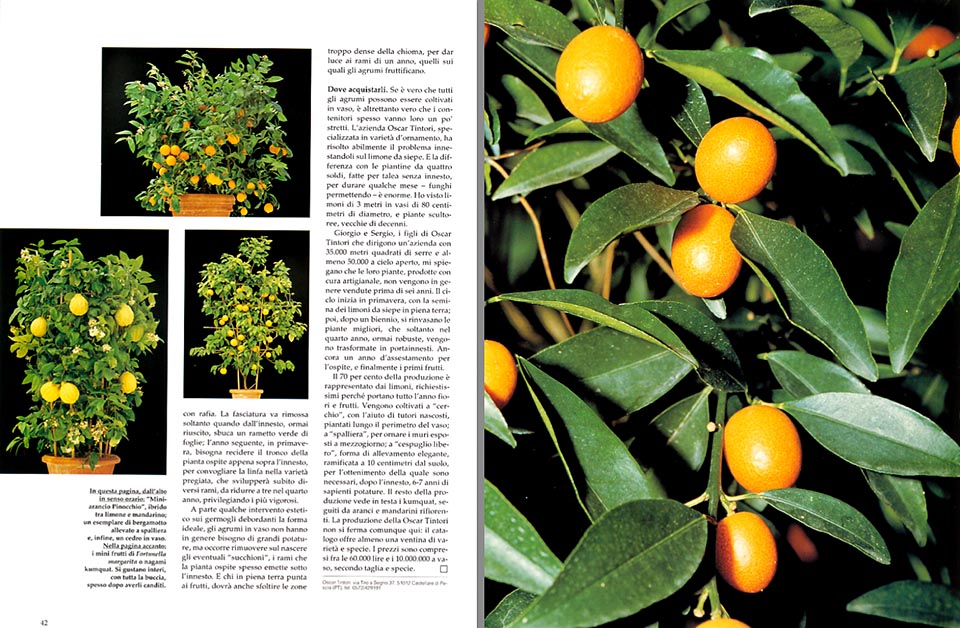

Texto © Giuseppe Mazza

English translation by Mario Beltramini
Rays of sun in full winter, when, around, the nature seems dead, citrus fruits reach our table rich of vitamins C, A, B1, B2, P, sugars, calcium, iron, potassium, phosphorus and magnesium.
Oranges, tangerines, lemons, grape fruits and citrons, not to talk of the varieties and of the hybrids, old and modern, which emphasize the already extraordinary virtues of these fruits.
For botanist, they are all berries, and assume the name of “hesperid”, in memory of the Greek myth which considers the oranges as the “golden apples”, in the garden of the Hesperides.
Externally, the “epicarp”, a showy peel full of small indents, rich of essential balsamic oil, which burns, crackling, in a flash, when approached to a flame; then the “mesocarp”, a white, porous layer, called “albedo”, bitter and indigestible, which is better to take off when you wish to utilize the peel; finally, the “endocarp”, formed by a transparent film, which contains, usually, from 5 to 12 “lodges”, the segments, full of innumerable cells elongated like spindles, full of juice, delicious reward for those who will disseminate the seeds.
Plants often naturalized in the Mediterranean climate, but which do not belong to our domestic vegetation.
When did they reach Italy? After a mosaic in Pompei, old Romans knew already several citrus fruits, tilled in their gardens for decoration and curative properties, but the opinions on the times and species, are not all in agreement.
The first to arrive has been, by sure, the Citron tree (Citrus medica), a low tree of 3-4 metres , of which talk the Greek Theophrastus, Virgil and Pliny. It was called mala medica, that is, “apple coming from the Media”, ancient region of Asia Minor, and the Latin name, which leads at once to think to the medicine, has therefore no connection at all with its presumed properties, rather changeable, however, in the various civilizations.
For Greeks and Romans, the juice was a panacea against rabies and the ailments of the old age; in the Middle-Age, on the contrary, they used the peel, deemed useful against biliary calculi; but later, in late Renaissance, physicians suddenly pass words and consider the whole fruit as dangerous.
If it did not cure the body, the Citron did, in any case, cure the spirit.
For the Jewish, it was a liturgical plant, present, even now, every year, in the Feast of Tabernacles, whilst a fingered variety (Citrus medica var. sarcodactylis), almost without pulp, with the fruit divided in sectors resembling the fingers of a hand, is offered, in all the eastern countries to the divinities, to perfume the pagodas.
The peel, sweet and thick, constitutes the 60-70% of the fruit, and it’s the side more used by industry. It is used to prepare candied fruits and jams, and makes part, with the juice, to the preparation of drinks and syrups.
Even if for somebody, the lemon (Citrus limon), was discovered by Romans in Asia Minor, during the wars against Alexander the Great, we know by sure from an Arab treatise, translated later on in Latin, that it was cultivated in Europe around the 1200.
Native from India, it has spread in Persia, Syria, and Palestine, while on the other border, it was growing, luxuriant, in Indonesia and in China.
As a further proof of these long voyages, an international name completely similar in distant languages: Ta-limum, and Sta-limum, in Chinese, Laimum in Arabic, and Limu in Indonesian. And it could not be otherwise, for fruits which were curing in a few days from the scurvy, rich of vitamin C and vitamin P (called also rutin), with a remarkable antihemorrhagic and healing action, not to talk of the digestive properties, or of the disinfectant and aromatic ones, on the food, in lieu of vinegar.
In Italy, the cultivation of this low tree of 3-5 metres, spread quickly. In the south, in the open land, and in the north, where climate if more severe, in pots sheltered in wintertime in dedicated places, called “lemon houses”, and nowadays, our production is still one of the most important in the world.
For the Orange, the name of which should come from the Arabic wording narangi, from Persian Nâgarang-a, “appreciated by elephants”, or, perhaps, for other glottologists, from the Latin aureum, with reference to the golden yellow fruits, the situation is similar, but we have to distinguish between the Bitter orange (Citrus aurantium), native of the southern side of Himalaya, and the Sweet orange (Citrus sinensis), native of China, very alike in the appearance, but with a sweet taste.
The first one was discovered by Romans in Asia Minor at the time of Alexander the Great, whilst the second one arrived in Europe only by the beginning of the XVI century, brought by Vasco de Gama, when back from India.
A tree high even 9 metres, with a precious fruit, with a good taste, which met immediately and enormous success, which has nowadays an annual production of 10-12 millions of Tons, and innumerable varieties, “blond”, and “sanguign”, for the joy of the table and the fruit juice more widespread industry in the world.
The Citrus aurantium, of smaller size, with more consistent thorns, in general, has more seeds. Cultivated in the Rivieras along the roads for ornamental purposes, it has a very limited production.
The pulp, very sour, is not edible, but from the bitter peel, they derive marmalades, candied fruits, bitter drinks and liquors.
Its flowers, very fragrant, furnish the precious “Neroli oil”, which enters the composition of the eau de Cologne, while from the leaves, particularly aromatic, they get the “petit-grain”, which has various uses in perfumery.
The Chinotto (Citrus aurantium var. myrtifolia), and the Bergamot (Citrus aurantium ssp. bergamia), are respectively a variety and a sub-species of the Bitter orange.
The first one, not higher more than three metres, known also as Suntana, or Myrtle-leaved orange, is recognizable at once by the small, deep green, foliage laminae, very bright, and by the intense fragrance of the flowers, fleshy and brilliant like China ware, enriched of showy tufts of yellow stamens.
The fruits, similar to mandarins, are considered, in India, as talismans, and are placed in the linen of sick people, or of those who have to carry out a voyage, in any case, they have a fairly good deodorant and disinfectant power.
Italian production, not considering the ornamental employments in pots, is concentrated in the south, and concerns the industries of drinks, liquors, candied fruits and cosmetics.
The Bergamot, which gets the name from Berga, a Spanish city, where, time ago, existed huge cultivations, has, on the contrary, the appearance of an orange.
Its fruits are not edible, but from the skin, which has a nice light yellow colour, they extract the homonym essence used in perfumery, and valuable candied fruits, with an intense taste, lightly bitter, but very palatable.
Several citrus fruits have been introduced quite recently.
The Grape-fruit (Citrus maxima), a 10-12 metres tree, native of the south-east of Asia, till Polynesia, seems having reached the coasts of Florida only a couple of centuries ago, to spread, later on, to North Africa, Israel, and in many Mediterranean countries.
The fruits, which can have a diameter of more than 15 cm., have good thirst-quencher qualities, and for their richness of vitamins, occupy a preferential place in the American breakfast.
The odd English name of Grape-fruit, that is of “fruit in clusters”, comes from the fact that, in spite of the size, the hesperids of many varieties are carried by grapes of 4-12, and even more, elements.
Recently, it has been discovered, by chance, when using it for rendering aromatic a medicine, the Grape-fruit juice helps the assimilation of many active principles, which result, then, 3-5 times more concentrated in the blood.
And when the specialists will be able to isolate this mysterious element, many medicines, destroyed by the digestion, and efficacious only via intramuscular injection, will be available also orally.
Also the Mandarin (Citrus reticulata), a 5-8 metres small tree, native of Philippines, and south-eastern Asia, is among the last come citrus fruits.
Called, also nowadays, “Maltese orange”, by the British, it reached, in fact, Europe from Malta, only in 1828; and its name doesn’t come from the “mandarins”, the famous Chinese dignitaries, but from “mandara”, that is, the way these fruits were called in the Island of Bourbon (now Island of Réunion), the important sea-port on the way to India, which was a primary stoppage of its long approaching travel towards Europe.
Apart the direct consumption, it interests the industry of candied fruits and of liquors, and also the unmistakable aroma of the skin, made its way in the world of perfumes and of cosmetics.
It has many famous varieties, like the Clementine, born from the cross-breeding with the Bitter orange, and the Mandarin orange, born from the marriage with the Sweet orange, which is called Tangelos, if the orange is a certain Moroccan variety, and Tangerine, if it comes from a Jaffa orange; and the Jambiris, born from the union with the lemon.
The Ornamental mandarin (Citrus mitis), coming from Philippines, is, on the contrary, a species relative to the Kumquats, sold with these ones, by Christmas time as “inner plants”, for the gay fruits of 3-4 cm. which will harmonize with the season decorations.
Kumquats, for their part, are two: the Marumi Kumquat (Fortunella japonica), coming from South of China and Indochina, about one metre high, with white flowersand 3 cm. fruits, almost round; and the Nagami Kumquat (Fortunella margarita), spontaneous in the region of Canton, high even 4 metres, with ivory coloured petals and oval fruits about 2 cm. wide.
The name of the genus come from the Scottish botanist Robert Fortune, who carried officially some specimen to Europe in 1846. The flowers are much perfumed, the leaves aromatic, and the fruits, tasty and digestible, are eaten entire, and with the skin.
Kumquats have been cross-breeded, with success, with the Lime (Citrus aurantiifolia), a citrus fruit of warm countries, half way between the lemon and the orange, with yellow-greenish fruits of 3-6 cm.; and not far from Ventimiglia, in the Garden of the citrus fruits of the Palais of Carnolès, in Menton, France, close to these odd lemon coloured “Kumquat”, it is possible to admire a rich collection of hybrids, among which, the Citrus x paradisi, born from the Grape-fruit and the Sweet orange, the “Lipo”, born from a lemon and a Grape-fruit, and the “Lice”, from a lemon and a citron.
Apart grafts, which can produce a plant carrying , on different branches, even seven diverse species, the possibility of hybridization of citrus fruits are practically unlimited, and this was well known by the gardeners of the Medicean villas in Tuscany, which , by the end of 1600, were numbering, as it appears from the paintings by Bartolomeo Bimbi, commmissioned by the Gand Duke Cosimo III, even 112 varieties, cultivated in pots.
At that time, as nowadays, man was anxiously seeking for the exotic, and the “unusual”, and authentic deformities were displayed with ostentation, like the jesters, at the drawing-rooms of the mighty people.
But many forms, thought to be the result of cross-breeding and clever grafts, were really the unforeseen result of viral attacks, or the work of the Acari of wonders (Aceria sheldonii), an insect which sucks the buds, creating monstrous fruits, such as horned of fingered lemons, with odd prominences, resembling to clutches.
CULTIVATING THEM
As they have a reduced, thin and superficial root system, all the citrus fruits adapt themselves quite easily to the cultivation in pots; and nowadays, thanks to the grafts on the Hedge lemon, which often dwarfs the guests, and fully exploits every centimetre of soil with its extremely thin roots, the huge containers of old times, big wooden cases, transported, with fixed poles, by four men, are generally replaced by the more handy pots in earthenware with “strong border”, adorned with relief and festoons.
The soil must be light and not too much calcareous, rich of organic substances; the drain perfect. It is convenient, therefore, to place on the bottom of the pots a thick layer of clay expanded at big particles, followed by a thin bed of river sand and old manure, well decomposed and boiled seeds of lupines, and then to finish with universal garden soil. The citrus fruits are all avid of nitrogen, and, particularly in the cultivations in pot, it’s good to administer them, several times a year, organic fertilizers, such as freeze-dried ox blood, or the “hoof and horn meal”, a precious crush with flakes of horns and bovine hoofs, which are to be embodied, gently into the soil.
And, in order to hinder the turning yellow of the leaves, due to shortages of iron, we can add, also, from time to time, some pinches of “Sequestrene”, a soluble powder, which, at the first watering, turns to a blood coloured puddle, immediately absorbed by the ground.
Citrus fruits must be changed of pot, usually, every 2-3 years, and moved to containers proportionate with their growth.
But when they reach the limit size, we must extract the plant with the dry soil, and reduce the clod on the sides, in order to add
fresh land, rich of humus, after having done the draining with an accurate cleaning of the pot.
We must be generous of water, but not too much.
In the cultivation in pot, when watering too much, we risk, in fact, to wash away the soil, depriving it of all nourishing inputs; and in open land, especially in the installation, if we have not foreseen to place under the roots a thick layer of draining pebbles, we have to pay attention to the staunching, which can happen, particularly in winter, when the underground streams of water increase their level.
These cause, in short time, rottenness and the spreading of microscopical parasite mushrooms, such as the Phytophtora, main cause of the so-called “gummosis”, usually hopeless sickness, where the plant, with yellow leaves and necrosis at the basis of the trunk, perspires a sort of gum.
Only the Bitter orange (Citrus aurantium), frequent in all gardens of the Riviera, and the Hedge lemon, with its hybrids, are exempt from this calamity.
And this is the reason why all other species of Citrus fruits, are, nowadays, systematically grafted on these plants.
Another mushroom, the Phoma tracheiphila, attacks mainly the lemons, causing the “dry sickness”, that is the obstruction of the small lymphatic vessels of the plant, with the fast fading of the sprouts; and it is necessary to destroy, at their birth, with suitable products, the invasions of the Red little spider (yellow leaves with little cobwebs on the lower lamina), of the ladybirds (small white, black, red or grey on the young branches and fruits, prominences), and of the Aphids (leaves deformed, curled, and stained by oily marks, produced by small green or brownish insects).
EXPOSURE AND WINTER TIME
Set before that oranges are generally more rustic than lemons, citrus fruits grow, depending on the species, between the 12.5° – 13° C and the 33° – 35°C, and love to bask in the sun, especially in wintertime.
In the Mediterranean climates, they can be generally kept in the open air, in places sheltered from the winds, but where the thermometer goes down, for long time, under the 7° – 8°C, we have to take action.
In fact, short icy weathers at -1°, -2°C, are sufficient for them to lose all the fruits; at -3°C, leaves fall down; and, at -8°, -10°C, the damages to the woody tissues are irreversible.
On the other hand, even if there are small size orange and lemon trees, which can be easily sheltered inside the house, citrus fruits do not endure the lack of sun and the dry warmth of modern flats.
The Clamandino (Citrus mitis), is the more adaptable, followed by the Kumquats and the Chinotto, but even if they gladden Christmas festivities with their small fruits, suitable to the season ornaments, they are, at the end of the story, poor “wasted plants”.
Once, close to the villas, did exist the “lemon houses”, where the big pots, which decorated the halls and the garden, were sheltered, more or less under glass, for the wintertime.
In a flat, a luminous window far from radiators, is a palliative for a maximum of a few weeks.
You need a luminous, but not heated, veranda on a “cold greenhouse”, which can be built on a small balcony, with plastic clothes fixed by solid wooden poles.
Some aeration holes are needed, and, during the coldest days, a small thermostat radiator can be useful, to avoid that the temperature drops under the 3° – 4°C, during the night.
AMUSEMENT WITH SEEDS
A well positioned window is sufficient, and all, after having eaten a citrus fruit, can amuse with the seeds.
You have to choose the bigger ones, better if already close to germination, with a characteristic “white small tail”, and you inter them, 4-5 at a time, in small 10-12 pots.
Watered regularly, they germinate after about one month, but, to avoid disappointments, even if you live in Riviera, you must know the “rules of the game”.
From the seeds of Oranges, Lemons, Hedge lemons, common Grapefruits, Manadarins, Calamandinos and Kumquats, come sons similar to the parents; but sowing the Botanic grapefruit or the Cedar, we get degenerated trees, with fruits of poor quality, surprisingly, which often do not even succeed in ripening.
And this theoretically, in the best of the cases, because in our country, all the citrus fruits, born from a seed, but the Bitter orange and the Hedge lemon, are doomed to die, sooner or later, victims of the Phytophtora.
We have then to confine ourselves to the two above species, on which we shall easily graft the preferred varieties, tested with success in the balcony or in the garden.
For the cultivation in open land, in calcareous soil, like in Riviera, we have to use the Bitter orange, which tolerates a pH = 7-8; whilst in pot and in acid soils, it’s normally more convenient the Hedge lemon, which, enduring frost, increases the resistance to inclement weather.
When, in April-May, after about one year, the small plants carrying the graft, pass the half metre of height, and have reached the diameter of a pencil, he who has the green hand will transform in surgeon, thus effecting some “sight grafts”.
It’s sufficient to carve the bark with a “T” cut, 20-30 cm. from the level of the ground (50 cm. for the trees to be cultivated in open land), and to lift it on the sides.
Simultaneously, you take away a bud with a piece of bark of the variety chosen, and you introduce it in the cut, binding well the wound with some raffia. The dressing is to be removed only when, from the graft, now successful, a small branch, green of leaves, comes out; and the following year, in springtime, you have to cut off the trunk of the plant host, just over the graft, in order to convey all the lymph into the valuable variety, which will immediately develop various branches, which are to be reduced to 3 during the fourth year, keeping the more robust ones.
Apart some aesthetic intervention on the sprouts exceeding the ideal form, citrus fruits in pot generally do not need many pruning, but we must remove at their appearance, possible “suckers”, that is the branches that the poor host plant, recalcitrant and tired to work for the other one, often emits under the graft.
And those who, in open land, look for fruits, will have to prune also the too thick areas of the top, in order to give light to the “one year branches”, where citrus fruits will fructify.
SCIENZA & VITA NUOVA + GARDENIA – 1995
